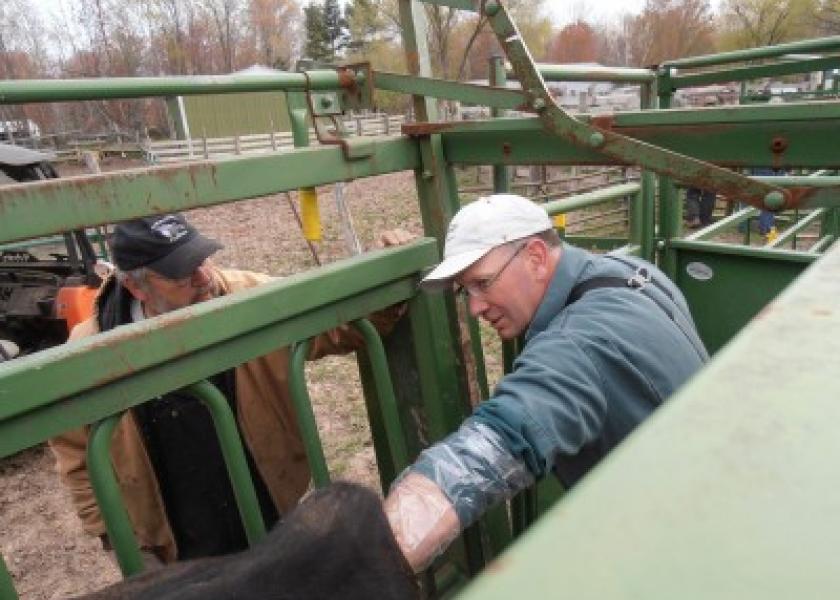Small Farm Series: Pregnancy Diagnosis

By: Justin Rhinehart, Assistant Professor, University of Tennessee Beef Cattle Extension Specialist
In a recent article about managing the calving and breeding season, the topic of pregnancy diagnosis (“preg. checking”) was briefly mentioned. And, last year you might remember seeing an entire article devoted to it. It is worth revisiting here and focusing the discussion on implementing pregnancy checking in a small herd setting. Remember, we are defining a small herd as 30 or fewer cows; a one-bull unit.
The most ideal time for most small scale producers to pregnancy check their cows is at weaning. It can certainly be done much sooner. But, most cattlemen will keep an open cow until it weans the calf it is currently nursing. Doing it at weaning can reduce the number of times the cows need to be worked in a year. But, if pre-weaning vaccinations are part of the management plan or it is relatively simple to work the herd, pregnancy checking can be done as early as 30 days after the end of the breeding season.
There are several methods available for pregnancy checking. The most common method is still palpation. The cattle are individually restrained and the technician (usually a veterinarian), palpates the reproductive tract to determine is a fetus is present. Experienced technicians can do this very accurately and some can do it very early in pregnancy. Aside from determining whether they are pregnant, the technician can also estimate when they will calve and determine if there are any problems with the reproductive tract. This additional information can be very important for identifying problems that lead to low pregnancy rates.
Ultrasound is becoming more widely used as cost of the technology is decreasing. Ultrasound still requires rectal palpation because the probe has to be positioned directly over the cow or heifer’s reproductive tract. Experienced technicians can accurately determine pregnancy as early as 30 days after breeding with ultrasound. It can also be used to determine if the calf is a bull or heifer if done between about 60 to 90 days after breeding. Again, this method yields immediate results and can be used to estimate when they will calve. As with manual palpation, the technician can often identify reasons a cow or heifer did not become pregnant or other issues that might need to be addressed.
The newest way to determine pregnancy status of cows and heifers is the blood pregnancy test. For this method, a blood sample is taken from each cow or heifer (usually from the tail vein) and sent to one of several commercial laboratories. Within a matter of days, sometimes even the next day, the lab will send back results for each individual female. This method works by detecting a molecule in the blood called a pregnancy specific glycoprotein (PAG). These PAGs are only produced by a placenta. So, if used correctly and PAGs are present in the cow or heifer’s blood, that female is pregnant.
Blood pregnancy tests can be used as early as 28-30 days after breeding (depending on the lab and their specific assay). It is important to realize that PAGs can stay in the cow’s blood for as much as 80 days after calving. So, taking the blood sample too early can lead to a false positive test result. These tests are very accurate but might result in an occasional false positive where the cow/heifer is called pregnant but does not calve. Most often, the female was actually pregnant when the sample was taken but loses the pregnancy before calving. The same thing can happen with the other methods of pregnancy determination.
A common question is: “How much does it cost to pregnancy check cows?” Prices for palpation are different among technicians and between methods. Ultrasound is usually more expensive than manual palpation and the blood test is relatively inexpensive per sample. But, a more appropriate question is: “How much does it cost NOT to pregnancy check cows?” Especially for small herd operators, where hay and supplemental feed are more expensive from being purchased or made on a smaller economy of scale, feeding open cows or heifers is extremely wasteful. Consider this; it can cost as much as $650 a year to maintain a commercial cow. If a cow does not produce a calf, that investment turns into lost profit potential. It does require additional investment to replace open cows. But, that should be weighed against its salvage value and recouped resources, not just the purchase price of replacements.
If pregnancy checking is one of those management practices that you are still not quite convinced is a money maker, consider at least trying it for the first time on replacement heifers. These heifers already represent a loss of income because they were not sold as feeder calves. They also required additional resources (grass, hay, supplemental feed etc.) that could have been used to keep the mature cows in better shape. Identifying open heifers as soon as possible after the breeding season allows you the opportunity to recoup more salvage value by selling a heavy feeder heifer (800 lb. for $2.00/lb.) as opposed to a cull cow (1100 lb. for $1.06/lb.) that has eaten hay and feed all winter and did not calve. Identifying just one of those open heifers saves enough money to pay for pregnancy checking the entire average size herd.
“Preg. checking” is a good investment and NOT doing actually cost more than paying to get it done. If it still seems like a mystery or something that only large-scale cattlemen do, consider visiting with your veterinarian or local UT Extension Agent. You will almost certainly find that it is one of the easiest and most rewarding practices you will implement. If you are already doing it, ask about ways to improve the timing and using the data to tighten up your calving season.







